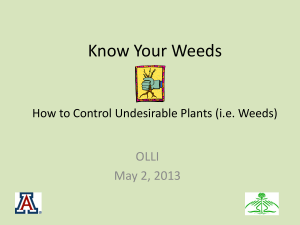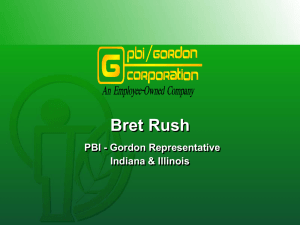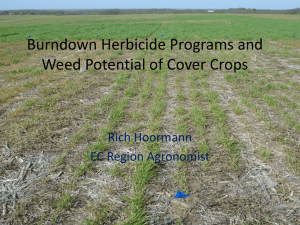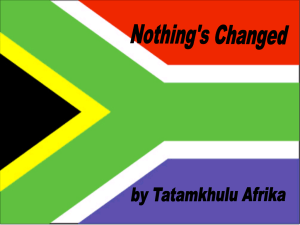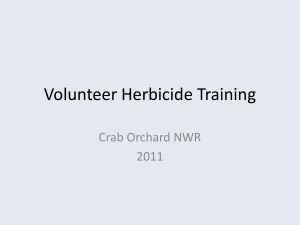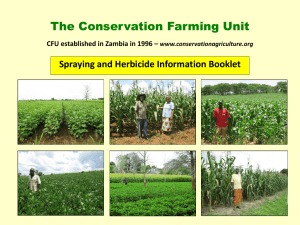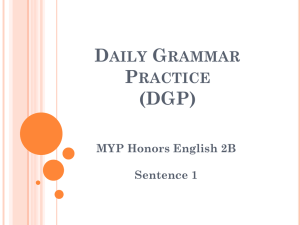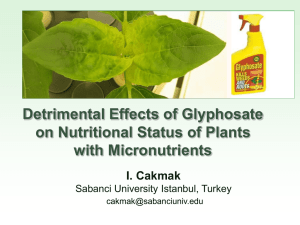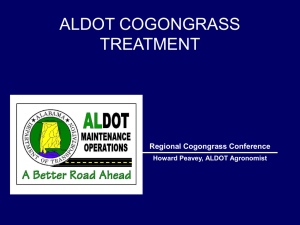and Read Full Article - Maine Christmas Tree Association
advertisement
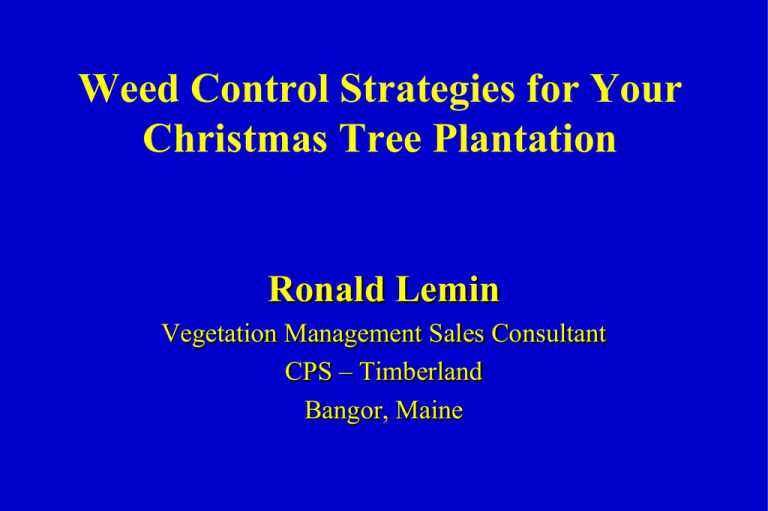
Weed Control Strategies for Your Christmas Tree Plantation Ronald Lemin Vegetation Management Sales Consultant CPS – Timberland Bangor, Maine INTEGRATED PEST MANAGEMENT (IPM) A decision making process that integrates into a management system, a combination of practical pest management strategies to prevent or control pests in ways to reduce health, environmental and economic risks. IPM as Defined by Maine Statute (Title 7, Chapter 423) The selection, integration and implementation of pest damage prevention and control based on predicted socioeconomic and ecological consequences, including: IPM Understanding the system in which the pest exists. Establishing dynamic economic or aesthetic thresholds to determine whether the pest warrants control. Monitor pests and natural enemies. When needed selecting the appropriate system of cultural, mechanical, genetic, biological or chemical prevention techniques for desired suppression. Systematically evaluating the pest management approaches utilized. IPM Council Mission To define, promote and enhance implementation of IPM practices that reduce or minimize harmful environmental and human impacts of pesticides and other management practices. The Council will promote the education of the public regarding the need, benefit, and practices of IPM. Current IPM Council Activities Raising awareness, appreciation, and understanding of IPM (consumers and public audiences) WWW.GotPests.org is our website which was developed in collaboration with MBPC Recognized by EPA as an Environmental Stewardship Partner Meet 2-4 times per year in Augusta (open to the public) For more information contact Kathy Murray Kathy.murray@maine.gov 287-7616 What is a Herbicide? They are one type of “pesticide” such as: insecticide, fungicide, bactericide, etc. Relatively low in toxicity Work on enzymes only found in plants, not in humans, animals, and insects Herbicide Modes of Action Selective or non-selective Residual or non-residual Foliar absorbed, Root absorbed, or Both Post-Emergent, Pre-Emergent, or Both Contact or systemic Application Methods Aerial – Helicopter or Fixed-wing Ground – Skidder, Tractor, ATV Backpack Foliar - Mistblower, Manual Backpack - Basal Bark Stump Treatments Tree Injection Granular Small Droplets – Be Careful of Inversions! SURFACTANTS Added to the solution to alter the dispersing, spreading, or wetting properties of the spray droplet. Reduces the surface tension of the water droplet. Increases the contact surface area of the droplet, better efficacy. Soaps Foliar Absorption Barriers to foliar absorption: High surface tension – no surfactant Low surface tension – with surfactant Leaf cuticle – waxy covering on leaf epidermal cells, herbicide moves through by diffusion, also enter through cracks in the cuticle, surface tension of spray droplet critical Source: Anderson 1996 Questions? 2011 NEW ENGLAND GUIDE TO CHEMICAL WEED AND BRUSH CONTROL IN CHRISTMAS TREES Coordinated and edited by: J.F. Ahrens, Connecticut Agricultural Experiment Station, Windsor CT Copies can be downloaded from the University of New Hampshire Cooperative Extension website: http://ceinfo.unh.edu/nrnpubs.htm Link To Obtain a Copy Online http://extension.unh.edu/resources/files/resource000845_rep2560.pdf A BASIC WEED MANAGEMENT PROGRAM Identify the problem weeds, evaluate control strategies. Monitor weeds before bud break in the spring and in July and August to help make decisions. Calibrate application equipment or plan on spot treatments. Select proper rates using this guide, read the labels, and follow label directions. Consider Apply site preparation before planting. pre-emergence herbicides in the early spring. Combine herbicides to control your problem weeds A BASIC WEED MANAGEMENT PROGRAM Following a June evaluation, consider whether additional treatments are needed for problem weeds; for example: Vetch, or other uncontrolled weeds. Plan on a fall treatment with Roundup or Garlon to control perennial weeds, ferns and brush. Keep good records of equipment calibration, products used and dosages and dates applied. GENERAL CONSIDERATIONS Treat perennial weeds with Glyphosate (Roundup) one or more times the year before planting. Organic mulches such as wood chips, or pine needles conserve moisture and control many weeds alone, or can be used in addition to pre-emergence herbicides. Certain herbicides are safely sprayed directly over the trees (Princep, Goal, Devrinol, Surflan), whereas others must be applied as directed sprays, where contact with conifer foliage is minimized or avoided entirely (Roundup, Garlon, etc.). GENERAL CONSIDERATIONS Field planting in pre-killed sod is faster and herbicides applied after planting are used at lower rates. Band treatments require less herbicide per acre of trees, save money, and also prevent soil erosion on slopes. Bands 24 to 30 inches wide are satisfactory for two years, but as the trees grow, the treated bands should be widened. Spring-applied herbicides are usually required each year until the trees are large, but dosages may be reduced after the second or third year. GENERAL CONSIDERATIONS Spraying of brush or resistant weeds is done only as needed. Soils higher in organic matter require higher rates of pre-emergence herbicide than sandy or gravelly soils low in organic matter. Fully and Semi-Directed Sprays Semi-Directed Sprays are applied so that only the basal 8 - 12 inches of the conifers are contacted. Application is usually with the use of off-center nozzles or wide-angle nozzles mounted low. Fully-Directed Sprays are applied in ways that avoid contact with conifer foliage such as the attachment of an 8 inch funnel to the nozzle of knapsack sprayers, or using shields on tractor mounted sprayers. BARRICADE, DEVRINOL, PENNANT, PENDULUM, SURFLAN, and TREFLAN All control some broadleaf weeds, but are primarily effective in controlling annual grasses. For broad spectrum pre-emergence control these herbicides are often combined with broadleaf herbicides such as Princep, Gallery, or Goal. BARRICADE (Prodiamine) A long-residual preemergence herbicide for field grown conifers. It is similar to Surflan in chemistry and spectrum of weed control. Barricade should not be used in seed beds or transplant beds. BASAGRAN T/O (bentazon) A contact postemergence herbicide that controls yellow nutsedge, Canada thistle, musk thistle and certain broadleaf weeds like ragweed, velvetleaf, dayflower, etc. A rate of 1.5-2 pts per acre with 1 quart of crop oil concentrate. White pine is tolerant sprayed over-the-top but fully directed sprays are needed to prevent foliar injury to most other conifers. SURFLAN AS OR ORYZALIN AS (oryzalin) A long-residual pre-emergence herbicide for field-grown conifers. It controls annual grasses and some broadleaf weeds, but does not control sedges or perennial broadleaf and grass weeds. Douglas fir and Fraser fir seedlings in transplant beds have been injured, but 3- or 4-year-old plants have been tolerant. It should not be used in seedbeds or transplant beds! TREFLAN 5G or 4E (trifluralin) Related to SURFLAN but is volatile and requires incorporation by tillage or irrigation. It can be incorporated into the soil ahead of transplanting. It is not safely used in conifer seedbeds. STINGER (clopyralid) Systemic herbicide used to control vetch, legumes, thistles, horseweed and other broadleaf weeds. It has no effect on grasses, sedges, or most woody brush and can be safely sprayed over established conifers. Can be used alone or combined with other herbicides such as Goal in early summer or Glyphosate in fall as a semi-directed spray. Can cause damage to newly planted conifers in transplant beds. SUREGUARD 51 WDG (flumioxazin) Broad spectrum preemergence herbicide with some postemergence activity on some weeds. Controls several triazine-resistant weeds. Apply prior to bud break, and do not apply to seedbeds. Combines well with Glyphosate when weeds are emerged, but alone has little effect on perennial grasses and nutsedge. 12 oz per acre provides equal or better results than combinations of Simazine and Oryzalin PENDULUM 60% WDG, 3.3EC, 3.8 AQUACAP, HURDLE 3.8 ACS (pendimenthalin) Chemically related to Surflan. The AQUA CAP and HURDLE formulations are microencapsulated, sprayable forms. While these are registered for several Christmas tree species, their may be risk to young seedlings. The water dispersible granule (WDG) formulation is preferred after conifer bud break. GLYPHOSATE Products (Roundup Original, Glyfos, Glystar, Credit 41, Mirage, Roundup Original Max, ect) More than 40 different types of Glyphosate products are on the market, not all registered for Christmas Trees. They vary in concentration and many contain surfactants that can injure conifers. All these products are safe to use if you can prevent contact with the foliage. Ask your supplier for the 41% product that is similar to the Roundup Original. GLYPHOSATE Products (Continued) Glyphosate is a foliar-absorbed systemic herbicide that is rapidly inactivated in soil and controls most weed and brush species with the right doses and timing. Quackgrass must be actively growing and over 6 inches tall, and perennial weeds should be in flower bud or later stages at treatment. Woody brush, poison ivy and brambles are best controlled in August or September, before frost. GLYPHOSATE Products (Continued) To provide residual control of weeds from seed, glyphosate must be followed or combined with a pre-emergence herbicide. Weeds not usually controlled with glyphosate include perennial vetch and Asiatic dayflower. GLYPHOSATE Products (Continued) Glyphosate sprays will injure the foliage of conifers. Conifers are most resistant to semi-directed basal sprays (where only the basal branches of conifers are sprayed) with Roundup Original or Credit late in the season (late August, September) and most susceptible during active growth. Douglas fir and white pine are more susceptible to injury than spruces or true firs (Abies spp.) Adding surfactants or emulsifiable formulations of herbicides such as Goal or Pennant to Roundup Original or Credit increases injury potential on conifer foliage. GLYPHOSATE Products (Continued) Roundup PRO and Roundup ULTRA are 41% glyphosate formulations that contain surfactants which make them faster acting on weeds and more injurious to conifers than Roundup Original or Credit. Sprays of these products should not contact conifer foliage. Roundup ULTRA MAX (50.2% glyphosate) should be considered for preplant and fully directed spray only. Glyphosate is applied in the fall and pre-emergence herbicides are applied in the early spring. To prevent winter annuals from invading in the fall it is common to add simazine (Princep, Simtrol) at 1 to 1.5 lbs. active ingredients per acre to the fall glyphosate sprays FUSILADE(fluazifop-P), ENVOY (clethodim) Systemic postemergence grass herbicides that control or suppress grasses with no effect on broadleaf plants and sedges, and have little or no residual activity in soil. Immature grasses are more susceptible. Can be sprayed over conifers and combined with or followed with simazine. Summer tank mixes with Goal are also effective. PENNANT MAGNUM (s-metolachlor) A pre-emergence herbicide that is applied in early spring before bud break. It controls yellow nutsedge and annual grasses in transplant beds or field-grown conifers. Comines well with Simazine or Goal for broad-spectrum control, but not safely used in seedbeds. Second applications may be needed for season-long control of nutsedge. TOWER 6E (dimethenamid-P) A pre-emergence herbicide similar to Pennant that controls yellow nutsedge and annual grasses, but differs in that it will control ragweed and lambsquarter. It does injury white pine and other conifers during active growth and should be applied before bud break. It fails to control perennial grasses and weeds and should be applied after a glyphosate treatment. WESTAR (sulfometuron methyl, hexazinon) A combination of two active ingredients for a broader control of annual and perennial weeds including quack grass, ragweed, lambsquaters, yellow nutsedge, horseweed and many others. It is safely applied on dormant trees before bud break but applications after bud break will injure conifers. Trail use in Christmas trees is suggested at 6-10 oz per acre. Lower rate on newly planted trees. Adding glyphosate to the mix improves control of other weeds. Do not use in seed beds or transplant beds. GALLERY 75DF (isoxaben) A pre-emergence herbicide that controls most annual broadleaf weeds and suppresses annual grasses. It controls weeds for 3 to 4 months or longer by root activity and can be sprayed overthe-top of labeled conifers. It does not control emerged weeds. For broad spectrum control of annual weeds it can be combined with preemergence grass herbicides such as Surflan, Devrinol, or Pennant and the post-emergence herbicides Goal or Stinger. GALLERY 75DF (isoxaben) Use in plantations but not in seedbeds or transplant beds. It is a potential alternative to Simazine on freshly tilled sites or on sites where glyphosate is used to kill established weeds. Gallery could substitute for Simazine for reduced leaching potential in aquifers. GOAL 2XL (oxyfluorfen) A pre-emergence and post-emergence herbicide useful for annual weed control in seedbeds, transplant beds, and Christmas trees. Dosages vary with the size of the conifers and the length of control desired. Pre-emergence control of broadleaf weeds lasts longer than control of grasses. GOAL 2XL (oxyfluorfen) Goal causes contact injury on spruces and true firs during rapid growth. Avoid applications on those conifers during the 5 to 6 week period following bud break. Emerged chickweeds, spurge and annual grasses are tolerant of Goal, but seedlings of purslane, carpetweed, pigweeds and several other weeds are controlled. Goal could substitute for simazine for reduced leaching potential in aquifers. SIMAZINE products (Princep 4L , Princep Caliber 90, Simtrol) Broad-spectrum At pre-emergence herbicides. low rates they fail to control annual grasses, but at high rates they control certain established perennial grasses when applied before growth starts in the spring. Both sprays and granules are safely applied over the tops of tolerant plants. SIMAZINE products (Princep 4L , Princep Caliber 90, Simtrol) Simazine combines well with pre-emergence "grass herbicides" such as oryzalin, metolachlor or pendimethalin to provide broad-spectrum preemergence control. Conifer tolerance varies with the species and age. Therefore, lower rates are used in transplant beds and on field-grown spruce than on firs or pines. TRICLOPYR products (Crossbow, Garlon 3A, Garlon 4 Ultra, AquaSweep) Systemic weed and brush herbicides, useful in site preparation or around conifers in late August or September, before leaf drop of target weeds (Garlon 3A). They can be applied in water during the growing season or in oil for basal applications on brush during the dormant season (Garlon 4). Garlon 4 can produce vapors that injure actively growing conifers during hot summer weather. Triclopyr controls vetch, other legumes, goldenrod, bedstraw, brambles, many other broadleaf weeds and TRICLOPYR products (Continued) It is especially useful to control susceptible broadleaf weeds in row middles where grass cover is desirable. It also is more effective than Roundup in controlling oriental bittersweet in early fall. Conifers established for three full years tolerate semidirected basal sprays of triclopyr in September. Crossbow is a combination of 2,4-D and triclopyr, useful in spot treatments (fully directed sprays) for woody vines and brush. AquaSweep is a 2,4-D. Garlon 3A combination that can be used for brush control outside the plantation. Product Availability Round Up Original is no longer being produced by Monsanto Mirage, Honcho, Ranger are other identical products produced by Monsanto. Key component is a 4lb product with the 7.5% surfactant load. Credit 41 is a 4lb product with the 7.5% surfactant load provided by CPS. QUESTIONS? What is WPS? WPS is the Worker Protection Standard set by the Federal EPA to protect farm, forest, greenhouse, nursery workers and pesticide handlers from pesticide exposure. WPS applies to anyone who uses pesticides in the production of agricultural plants on farms, forests, nurseries or in greenhouses. Whether or not you employ agricultural workers and pesticide handlers, all applicators of agricultural pesticides are required to comply with PPE and REI statements on the labels. What is Required Under WPS? INFORMATION – employees will be informed through training, posters, access to labeling, and REI notification for treatments. PROTECTION – ensure that your employees will be protected from exposure to pesticides, during application and within REI intervals. MITIGATION – decontamination sites, wash stations, emergency assistance, labels and MSDS for medical personnel. Contact the Board of Pesticides Control for More Information to Help You Comply With the WPS Standards Common Herbicides use in Small Woodlot Management ARSENAL (Imazapyr) RODEO, ROUNDUP (Glyphosate) GARLON 4 ULTRA AND GARLON 3A (Triclopyr) PATHFINDER II (Triclopyr and basal oil) ARSENAL Imazapyr, 4 LBS ACTIVE PER GALLON ORIGINALLY DEVELOPED AS A POSSIBLE DRUG WATER SOLUBLE SALT NON VOLATILE AMINO ACID INHIBITOR MERISTEMATIC GROWTH INHIBITOR BOTH ROOT AND FOLIAR ACTIVE POOR LEGUME, RUBUS, AND FORB CONTROL USED IN TANK MIX FOR MAPLE CONTROL NONIONIC SURFACTANT TO INCREASE EFFICACY IMAZAPYR - SOIL BEHAVIOR WEAKLY BINDS TO SOIL PARTICLES ADSORPTION INCREASES WITH OM AND CLAY DEGRADATION WITH SOIL MICROBES SOIL HALF-LIFE FROM 19 TO 34 DAYS WEED CONTROL UP TO 2 YRS DEPENDING ON RATE REMAINS IN THE TOP 30 CM OF THE SOIL LATERAL SOIL MOVEMENT IS LIMITED RODEO (Concentrate)-ROUNDUP Glyphosate, 40 or 54% ACTIVE PER GALLON NON VOLATILE,WATER SOLUBLE SALT AMINO ACID INHIBITOR DEPLETION OF 3 ESSENTIAL AMINO ACIDS FOLIAR ACTIVE ONLY LOCKS UP TIGHTLY TO SOIL MOLECULES ACCORD USED FOR CONIFER RELEASE NONIONIC SURFACTANT TO INCREASE EFFICACY RODEO (Concentrate)-ROUNDUP ROUNDUP CONTAINS NONIONIC SURFACTANT GLYPHOSATE IS A NON-SELECTIVE HERBICIDE NO SOIL RESIDUAL ACTIVITY COVERAGE IS ESSENTIAL EPA CLASSIFIES GLYPHOSATE IN CATERGORY “E” (EVIDENCE OF NON-CARCINOGENICITY FOR HUMANS), “E” BEING THE MOST FAVORABLE GLYPHOSATE - SOIL BEHAVIOR RAPIDLY ADSORBED TO SOIL SOIL AND ORGANIC MATTER ARE GLYPHOSATE’S WORST ENEMY. REQUIRES CLEAN WATER FOR MIXING PLANTING CAN OCCUR IMMEDIATELY AFTER APPLICATION MICROBIAL DEGRADATION SOIL HALF LIFE OF 47 DAYS GARLON 4 Triclopyr 44% ACTIVE INGREDIENT PER GALLON ESTER FORMULATION WITH MSO CARRIER VOLATILE AT HIGH TEMPS AND LOW REL. HUMIDITY NO GRASS CONTROL - SELECTIVE TYPICAL AUXIN-TYPE PLANT RESPONSE ABSORBED THROUGH THE FOLIAGE, BUT ALSO ROOTS, BARK, AND STEM GARLON 4 INDUCES CELL ELONGATION, UNCONTROLLED CELL DIVISION AND GROWTH. ADD TO WATER FOR FOLIAR TREATMENT CREATES AN E.C. WITH OIL (20%,80%) FOR BASAL APPLICATIONS OIL CARRIES THE TRICLOPYR THROUGH BARK FOLIAR EFFICACY IS BETTER IN EARLY-MID SUMMER DURING ACTIVE PLANT GROWTH GARLON 3A Triclopyr 3 LB ACTIVE INGREDIENT PER GALLON AMINE FORMULATION WITH 1% ETHANOL ADD A NON-IONIC SURFACTANT FOR BETTER EFFICACY IN FOLIAR TREATMENTS BEST FOLIAR EFFICACY IN EARLY-MID SUMMER DURING ACTIVE PLANT GROWTH PATHFINDER II Triclopyr 14% and basal oil 86% mix READY TO USE FORMULATION FOR BASAL BARK AND STUMP TREATMENTS BEST BASAL CONTROL ON STEMS LESS THAN 6 IN. YEAR ROUND APPLICATION EXCEPT WHEN SNOW PREVENTS APPLICATION TO THE GROUND TRICLOPYR IS TRANSPORTED THROUGH THE BARK BY THE BASAL OIL GARLON 4, GARLON 3A, AND PATHFINDER II- SOIL BEHAVIOR BINDS TIGHTLY TO SOIL OM AND CLAY PARTICLES BROKEN DOWN BY SOIL MICROBES AND SUNLIGHT SOIL HALF LIFE RANGES FROM 10 TO 46 DAYS FOR GARLON 4 AND PATHFINDER II, AND 30-45 DAYS FOR GARLON 3A MOST OF ACTIVE INGREDIENTS ARE FOUND IN UPPER 12 INCHES OF THE SOIL. Cut Stump Treatment with glyphosate or Garlon 3A Cut Stump Treatment with Garlon 4 and oil Applying Herbicide to a Girdled Tree Spaced Axe Frill Prepared for Herbicide Injection Basal Bark Application To Lower 12-18 Inches Aquatic Use Labels for Common Brush Control Herbicides Rodeo– Has the aquatic and terrestrial use labeling for several years. Glyphosate products with surfactant are not aquatic labeled. Imazapyr –BASF received labeling for 2 lb/gal imazapyr for aquatic use (Habitat marketed by SEPRO, Polaris by NuFarm). Triclopyr – DowAgrosciences relabeled Garlon 3A for aquatic use (Both on the Garlon 3A label and the SEPRO label as Renovate) All are pseudo Restricted Use under Maine’s Pesticide Regulations. Glyphosate versus Triclopyr Triclopyr (Garlon 4 and 3A work better early in the season before woody plants begin to shut down. Glyphosate works better later in the season as plants begin to produce sugars to store in the roots. Christmas trees can be more susceptible to Garlon 4 than Garlon 3A. Some Herbicides to be Cautious Milestone and Capstone – contain aminopyralid which is soil active and will move through the soil and damage softwoods. A good product to use in headland areas to control volunteer softwood brush Method, Viewpoint and Streamline – contain aminocyclopyrachlor (Imprelis) which can also cause severe softwood damage as it moves through the soil. Ronald C. Lemin, Jr. CPS Timberland Bangor, Maine 207-944-6160 ronald.lemin@cpsagu.com http://extension.unh.edu/resources/files/resource000845_rep2560.pdf
